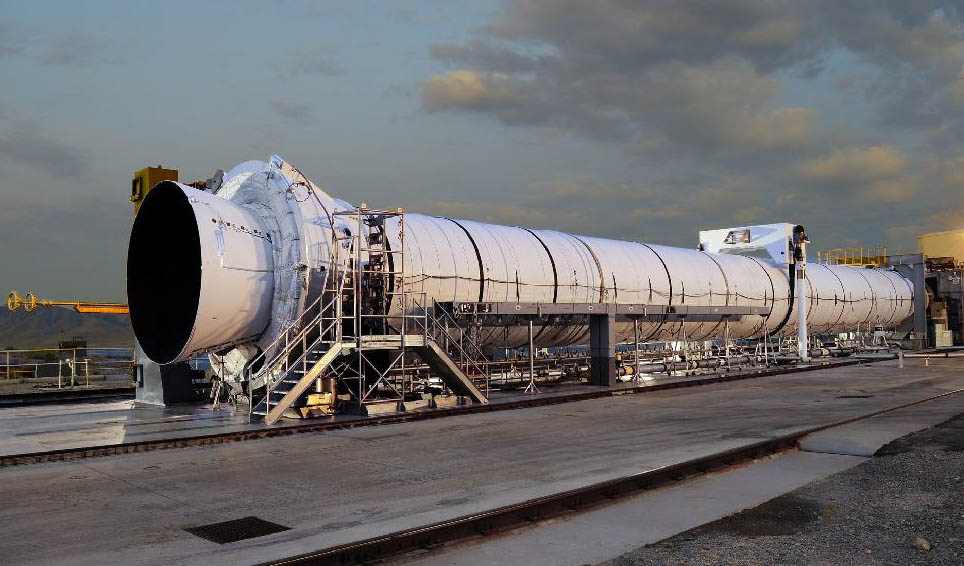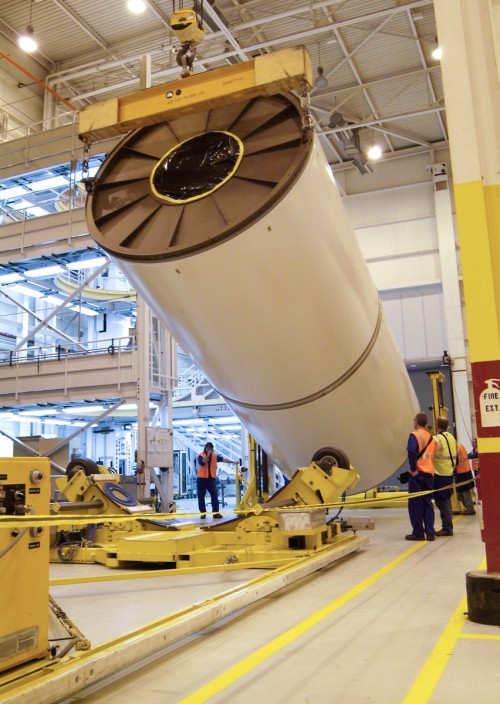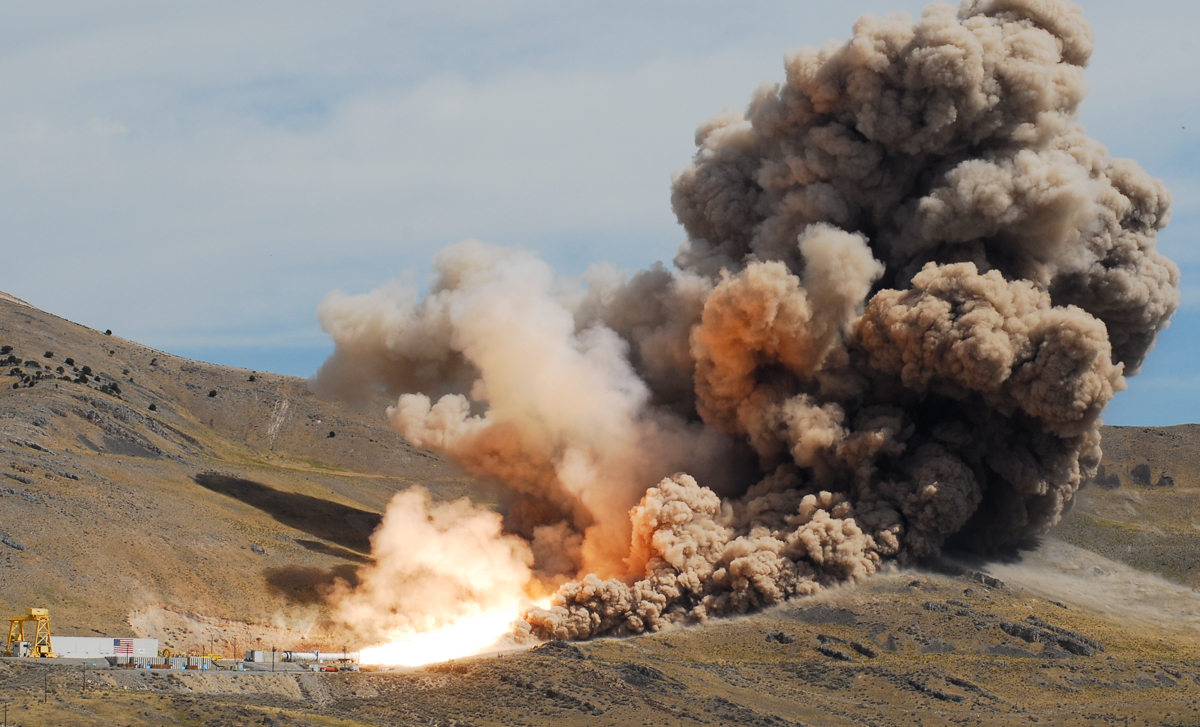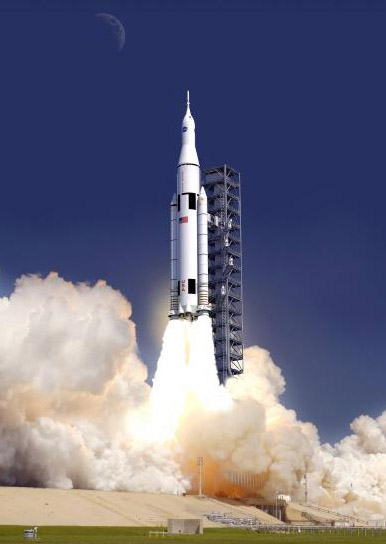
When NASA’s heavy-lift Space Launch System (SLS) rocket lofts the agency’s Orion deep space crew capsule for the first time in 2018, it will mark the beginning of a new chapter in America’s human spaceflight efforts, aiming for destinations beyond low-Earth orbit (LEO) by employing the largest and most powerful launch vehicle in history. The colossal 321-foot-tall SLS will thunder toward space on the power of four former (upgraded) liquid-fueled space shuttle RS-25 engines, but even with a combined thrust of nearly 2.5 million pounds those four engines alone won’t be enough to provide the 70-metric-ton (77-ton) lift capacity the initial SLS configuration promises. The rocket needs more power at launch to make NASA’s ambitious deep-space human exploration plans a reality, and this spring ATK is expected to test fire the largest and most powerful solid rocket booster ever built to help get the job done.
The company’s 154-foot-tall, five-segment solid rocket booster (SRB) has been in development for years, having been initially designed to launch NASA’s Ares rockets for the agency’s now cancelled Constellation program. The booster is similar to the four-segment SRBs that helped launch the space shuttles, but it’s larger and incorporates several upgrades and improvements. Now, after a lengthy investigation and trouble-shooting effort to determine root cause(s) and corrective actions for the existence of small voids discovered between the propellant and outer casing of the booster’s aft segment, ATK is ready to move forward with plans for a full-scale test fire of the company’s SLS booster test article, Qualification Motor-1 (QM-1).

“When we were at CDR (Critical Design Review) we were still casting our last motor segment for the first qualification motor (QM-1),” said Gordon Russell, Manager of the Marshall Space Flight Center Program Office for ATK. “We were able to successfully put propellant into our final aft segment. It went through all the X-rays and had no propellant voids or anything, everything looked good, a perfect segment as far as we are concerned, and so it is now on its way through final assembly so it can be shipped to the test stand where we already have the other four segments stacked together.”
“We will be prepared for a full-scale qualification static motor test on March 11, 2015 at 9:30 a.m. MST,” added Russell. “That’s the date we are working towards.”
In the fall of 2012, ATK engineers detected small voids in the aft (fifth) segment of the QM-1 booster while performing standard x-ray inspections—something that is done with all solid rocket motors to help ensure a defect-free piece of hardware. The voids were discovered between the booster’s propellant and outer casing, where a specialized rubber insulation is used to provide thermal protection for the case. More specifically, the voids were located in the “propellant bond line,” which is meant to hold a contiguous bond between the propellant and the insulation that protects the casing from the booster’s extreme heat.
Voids in the insulation itself are not historically uncommon, and are more acceptable, but voids in the bond line are uncommon, and a bigger cause for concern, so ATK rejected that first QM-1 aft segment and recast a new one using a new Propellant/Liner/Insulation (PLI) manufacturing process. However, when engineers performed x-ray inspections on that second QM-1 aft segment they discovered similar voids, which forced ATK and NASA to stop production of more booster segments and focus their investigation on the new asbestos-free rubber insulation material itself, rather than the actual manufacturing process.
The new material was implemented as part of ATK’s long-term goal to eliminate asbestos in the insulation all together, and the new insulation material had already been qualified for shuttle flights years ago but never actually flew. The old insulation material used on the shuttle’s four-segment SRB’s are now obsolete, and the source for a key ingredient is no longer in business.
Three fully developed, five-segment SRBs have been fired up on ATK’s Promontory, Utah, test stand since 2009, with the most recent having been conducted in 2011, and all performed fine with the new insulation material. Those tests, known as the Development Motor test series (DM-1, DM-2, and DM-3), helped engineers measure the new SRB’s performance at low temperature, verify design requirements of new materials in the motor joints, and gather performance data about upgrades made to the booster since the shuttle program.

However, DM series motors are not subjected to the kinds of inspections that QM motors are—same as an actual flight motor is regularly inspected more thoroughly than both DM and QM motors—so any known voids in the DM series boosters did not present a concern (five-segment DM series motors passed all inspections and tests). However, when ATK finished the DM test series and proceeded to QM-1, NASA requested more thorough inspections of the QM series motors to determine whether or not the new insulation liner material would have a negative effect on the booster’s performance, and that is when the QM-1 aft segment voids were discovered.
Now, over two years after the first small voids were discovered, ATK is confident they have eliminated the problem, which engineers determined was caused by out-gassing. A new insulating method is now being used, layering the materials differently than was done previously to eliminate any out-gassing to the propellant, and now the focus has turned to getting the five-segment beast ready for the first QM test fire in Utah this spring.

“QM-1 is supposed to simulate a flight-like booster,” said Russell. “We will have a full aft skirt at the bottom with a whole Thrust Vector Control (TVC) system, and we will go through actuating the nozzle just like a flight to test that new TVC system for the first time.”
Once ignited ATK’s five-segment SLS booster will deliver an incredible 3.6 million pounds of thrust, which is equivalent to 22 million horsepower—each—and the SLS will employ two of the 1.6 million pound boosters (1.4 million is propellant) to help NASA’s future SLS missions escape the pull of Earth’s gravity and reach their deep-space destinations. The five-segment SLS boosters will burn for the same amount of time as the old shuttle boosters—two minutes—but they will provide 30 percent more power.
To help put the power of ATK’s five-segment SRB into perspective, consider this: If the heat energy of the booster could be converted to electric power, the two SRBs firing for two minutes would produce 2.3 million kilowatt hours of power, enough to supply the entire power demand of over 92,000 homes for a full day.
ATK booster avionics and control tests were completed in December 2013. Booster avionics testing was completed in April 2014, and completion of a significant structural test of the booster’s main attachment mechanism, the forward skirt, was completed in May 2014. Final validation testing of the booster aft skirt avionics command and control system was successfully completed in August 2014 with an off-motor aft skirt hot-fire test, which represented the last phase of testing for the final validation that planning, engineering, scripts, equipment, and people are all ready for the upcoming QM-1 static test fire.
ATK expects to conduct a second QM booster test fire, QM-2, a year after QM-1, and booster avionics qualification efforts are in work and will be incorporated into the vehicle qualification effort, the Design Certification Review, which is scheduled for completion in 2016.
Although ATK is tasked with providing the SRBs for at least the first two SLS flights in 2018 and 2021 (EM-1 and EM-2), later missions on the evolved SLS, which would be able to carry 130 Metric tons (286,000 pounds) to orbit, may fly on liquid-fueled boosters.
Want to keep up-to-date with all things space? Be sure to “Like” AmericaSpace on Facebook and follow us on Twitter: @AmericaSpace
Missions » SLS » QM-1 » Missions » SLS »




Sometimes one can’t help but wonder what would have happened if the baseline had been three well known four segment boosters instead of two new ones. 15% more thrust and zero development costs, which would have allowed more development money to the other pieces of the puzzle.